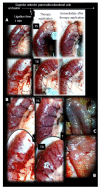Bypassing major venous occlusion and duodenal lesions in rats, and therapy with the stable gastric pentadecapeptide BPC 157, L-NAME and L-arginine
- PMID: 30598581
- PMCID: PMC6305534
- DOI: 10.3748/wjg.v24.i47.5366
Bypassing major venous occlusion and duodenal lesions in rats, and therapy with the stable gastric pentadecapeptide BPC 157, L-NAME and L-arginine
Abstract
Aim: To investigate whether duodenal lesions induced by major venous occlusions can be attenuated by BPC 157 regardless nitric oxide (NO) system involvement.
Methods: Male Wistar rats underwent superior anterior pancreaticoduodenal vein (SAPDV)-ligation and were treated with a bath at the ligated SAPDV site (BPC 157 10 μg, 10 ng/kg per 1 mL bath/rat; L-NAME 5 mg/kg per 1 mL bath/rat; L-arginine 100 mg/kg per 1 mL bath/rat, alone and/or together; or BPC 157 10 μg/kg instilled into the rat stomach, at 1 min ligation-time). We recorded the vessel presentation (filled/appearance or emptied/disappearance) between the 5 arcade vessels arising from the SAPDV on the ventral duodenum side, the inferior anterior pancreaticoduodenal vein (IAPDV) and superior mesenteric vein (SMV) as bypassing vascular pathway to document the duodenal lesions presentation; increased NO- and oxidative stress [malondialdehyde (MDA)]-levels in duodenum.
Results: Unlike the severe course in the SAPDV-ligated controls, after BPC 157 application, the rats exhibited strong attenuation of the mucosal lesions and serosal congestion, improved vessel presentation, increased interconnections, increased branching by more than 60% from the initial value, the IAPDV and SMV were not congested. Interestingly, after 5 min and 30 min of L-NAME and L-arginine treatment alone, decreased mucosal and serosal duodenal lesions were observed; their effect was worsened at 24 h, and no effect on the collateral vessels and branching was seen. Together, L-NAME+L-arginine antagonized each other's response, and thus, there was an NO-related effect. With BPC 157, all SAPDV-ligated rats receiving L-NAME and/or L-arginine appeared similar to the rats treated with BPC 157 alone. Also, BPC 157 in SAPDV-ligated rats normalized levels of NO and MDA, two oxidative stress markers, in duodenal tissues.
Conclusion: BPC 157, rapidly bypassing occlusion, rescued the original duodenal flow through IAPDV to SMV flow, an effect related to the NO system and reduction of free radical formation.
Keywords: BPC 157; Bypassing; Duodenal lesions; L-NAME; L-arginine; Major venous occlusion; Rats; Reduction of free radical formation.
Conflict of interest statement
Conflict-of-interest statement: The authors state that they have no conflicts of interest.
Figures








References
-
- Sikiric P, Seiwerth S, Rucman R, Drmic D, Stupnisek M, Kokot A, Sever M, Zoricic I, Zoricic Z, Batelja L, et al. Stress in gastrointestinal tract and stable gastric pentadecapeptide BPC 157. Finally, do we have a solution? Curr Pharm Des. 2017;23:4012–4028. - PubMed
-
- Seiwerth S, Brcic L, Vuletic LB, Kolenc D, Aralica G, Misic M, Zenko A, Drmic D, Rucman R, Sikiric P. BPC 157 and blood vessels. Curr Pharm Des. 2014;20:1121–1125. - PubMed
-
- Sikiric P, Seiwerth S, Rucman R, Turkovic B, Rokotov DS, Brcic L, Sever M, Klicek R, Radic B, Drmic D, et al. Stable gastric pentadecapeptide BPC 157-NO-system relation. Curr Pharm Des. 2014;20:1126–1135. - PubMed
-
- Sikiric P, Seiwerth S, Rucman R, Turkovic B, Rokotov DS, Brcic L, Sever M, Klicek R, Radic B, Drmic D, et al. Toxicity by NSAIDs. Counteraction by stable gastric pentadecapeptide BPC 157. Curr Pharm Des. 2013;19:76–83. - PubMed
MeSH terms
Substances
LinkOut - more resources
Full Text Sources
Medical

